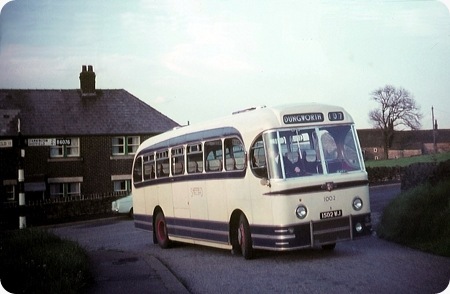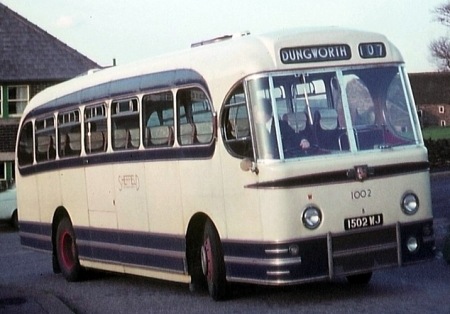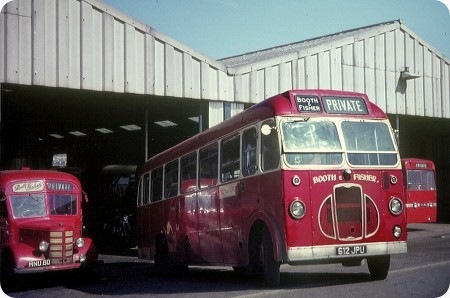Sheffield Corporation – Leyland Leopard – 1502 WJ – 1002
Sheffield Corporation
1959
Leyland Leopard L1
Weymann Fanfare C41F
This bus delivered as B fleet number 1302 was one of the first batch of six Leopards to enter service in the autumn of 1959. They made quite a stir being completely different from anything that had been purchased previously (if you exclude the one off AEC Reliance / Roe Dalesman of 1958 but which was not used on normal service for several years). 1302 was renumbered to 1002 in 1967. The Weymann Fanfare coaches were never converted for OMO whilst in Sheffield service and the photo shows 1002 complete with conductor reversing at the Dungworth terminus of the occasional 107 service on a lovely summer Sunday evening in May 1967. The 107 was an extension of the main service 7 to Stannington, another of those services to outlying hamlets which Sheffield seemed to specialise in and which made it so different from many other Municipal Operators. 1002 was withdrawn along with the rest of the batch in 1971 and was sold to Tiger Coaches (dealer) in Salsburgh, Scotland.
Photograph and Copy contributed by Ian Wild
———
15/06/2011 15:59
I have fond memories of these Fanfare bodied Leopards in the mid sixties.
My aunt and uncle used to keep the Dog & Partridge Inn at Bordhill on the climb to Woodhead pass and I spent many happy school holidays there. These coaches and the ECW bodied versions made the refreshment stop at the pub when working the X48 Sheffield/Manchester service and they were always crew worked.
I still have in my possession a letter from the Sheffield general manager thanking them for the hospitality shown to the crews and passengers over the years, when they left the pub in 1968.
Eric
———
Due to a few requests below is a closer shot of this vehicle, and why not.
———
16/06/11 – 09:32
Vehicles of my long lost youth! The excitement of living in Sheffield was that you never quite knew what to expect – and sometimes, in times of shortage – the B & C fleet Leopards emerged onto mundane tasks like the 8/9 Inner Circle or 38 Lowedges Road (much to my delight).
Wonderful picture, yet again, Ian. For obvious reasons, to those who know me, I wish that more Dalesmans and Fanfares had been built – both attractive and well built/finished bodies. These were quite the opposite of Duple and Plaxton who built buses in their slack, summer, period whereas Roe (in particular) and Weymann built coaches when they had a slack bus period. That being said, Weymann were a little more mainstream than Roe with major customers such as Southdown, Northern General Group, North Western – and smaller numbers for Devon General and South Wales.
These were the only Leopard Fanfares. Southdown had Tiger Cubs, everyone else had Reliances but Northern General also had some Guy LUF for one group company. These were the VERY FIRST Leopards built for and delivered to SJOC in July 1959 before the model was officially launched at the Scottish Motor Show the following November. Two more batches of Fanfares followed for SJOC B & C fleets as well as the ECW and Burlingham Leopards. The original six were first described as PSUC1 Tiger Cub specials but on delivery, this had been changed to L1 Leopard. (This was also interesting as the L1 was the bus version, the L2 the coach version – but ALL SJOC’s Leopard coaches were L1!)
Weymann crept back shortly after with two batches of Castilians for Southdown, lots of BET DPs in 1965 as well as multifarious coach bodies, in minute numbers, on Fords and Bedfords.
David Oldfield
———
16/06/11 – 11:20
The Burlingham Leopards also worked the X48, I had forgotten about those. I think I have a photo somewhere I took of a Burlingham Leopard stood outside the Dog & Partridge. I’ll see if I can dig it out, but as it was taken on a Kodak Instamatic it may not be good enough to reproduce.
Eric
———
17/06/11 – 18:07
1005 (1505 WJ) ended its days with Hulley of Baslow. 6170-6174 WJ also went to Hulleys of Baslow after a time with Midland Red.
See the undernoted picture on Flickr: www.flickr.com/
Seen in the picture are the "C" fleet Weymann Fanfares prior to going to Hulleys. The picture was taken at East Bank Garage in January 1970
Stephen Bloomfield
———
18/01/13 – 16:58
I can well recall 1505 WJ in Hulley of Baslow service . It was highly regarded by the drivers and passengers alike. After yeoman service it was withdrawn in May 1976. I believe it was sold for use as a towing vehicle in Essex and eventually scrapped in August 1978
Jerry Wilkes
———
19/01/13 – 06:16
And here are some of the Fanfares, as withdrawn vehicles, in Hulleys yard, plus a Yeates-bodied Bedford. www.flickr.com/photos
Chris Hebbron
Quick links to the - Comments Page - Contact Page - Home Page





